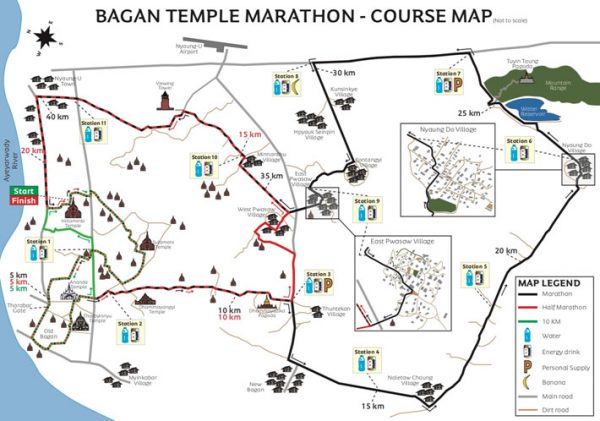BAGAN, 30 July 2019: Two young Asian tourists face a severe challenge. They are wondering how to snap a selfie at sunset without climbing one of Bagan’s crumbling pagoda ruins.
A guard senses what they are thinking. He approaches waving his arms gesturing at the majestic World Heritage pagoda and pointing to a brand new sign. It prohibits climbing or even walking through a monument’s courtyard.
The couple nods in compliance and hurries off to one of just a few remaining “viewing” mounds. There they can gain a little altitude enough to give their selfie a panoramic scan of hundreds of pagodas stretching as far as the eye can see. But they still think that climbing the pagoda would have been more fun.

Gone are the days when tourists clambered freely almost to the tip of a pagoda structure precariously balancing on ancient stones to capture the magic balancing trick for a Facebook post.
During the 43rd session of the World Heritage Committee 6 July, UNESCO officially inscribed Bagan to the World Heritage list, after almost 25 years since the military government first nominated the city.
Bagan’s Archaeological Zone, defined by Wikipedia as a 13 x 8 km area centred around Old Bagan, stretches almost to town airport in Nyaung U to the north and New Bagan in the south. The zone occupies an immense plain bordered by a sweeping bend of the Irrawaddy River.
Following the listing, Bagan’s local authorities drafted more guards to enforce the ban on climbing or walking through moment courtyards. Many of the structures are precariously at risk from footfall, traffic not to mention the odd earthquake tremor
The Department of Archaeology and National Museums counts more than 3500 pagodas and monuments in the World Heritage site despite losing 400 historical structures to an earthquake in 2016.
Since then, authorities discouraged climbing the monuments, while residents are keener than ever to keep the footfall at a respectable distance from their homeland treasures.
But visitors to Bagan still dream of capturing that iconic photoshoot depicting hot-air balloons gracefully drifting over the pagodas against the backdrop of a glorious sunrise.
Some of them voiced disappointment after travelling thousands of miles to capture the Bagan experience
Mizzama an online news service reported the frustration in an interview with William Wright, an American traveller, last week.
“Watching the magnificent sunrise and sunset views is my greatest expectation in Bagan. I have driven around the temples for three days to search for a good spot with a brilliant view, but there are no temples allowing people to climb up anymore.”
If you love to work up a sweat and get close to the wonders of Bagan, there is an alternative. You can run around the ruins once a year, and it beats scrambling up the stonework to take yet another typical Bagan selfie.
The 2019 Bagan Temple Marathon is now set to be the second marathon in Southeast Asia following a route within a UNESCO World Heritage park. The other follows a trail around the Angkor Wat Historical Park in Siem Reap, Cambodia.
The Bagan Temple Marathon, 23 November, coincides with the peak season when tourists flock to Bagan. The weather is cool and hot-air balloons are out in force every dawn providing the backdrops for spectacular photos. Runners need to register early to secure a room and place at the starting line, which is limited to just 500 participants who buy a package that includes accommodation tours and transfers.
The Bagan Temple Marathon starts and finishes at the 12th century Htilominlo Temple and passes other ancient monuments in the heritage zone and then circles the vast park through villages and back to the starting line.
Testimonials abound on the official website, but this one from a veteran marathon with 13 successful events under their belt stands out.
“The race was a great experience, and the early start was good as it was not that hot. Seeing the sunrise after 20 minutes, the temples, hot air balloons and buildings was a breathtaking sight – unforgettable. After running in the area of the temples and pagodas, the route took us through fields and near a dam and later through some villages making the whole marathon route diversified.”
There are three category distances; the fast 10 km, a 21 km half marathon and the gruelling 42 km marathon.
Danish sports event company, Albatros Adventure Marathons that manages the Great Wall of China marathon launched the Bagan Temple Marathon in 2013.
For international runners, the organisers bundle the race entrance into an eight-day package ex-Yangon that costs USD1,598 for five/four-star accommodation and USD1,348 for three-star. It includes the race registration all transport ex-Yangon, (flight to Mandalay) a day river cruise from Mandalay to Bagan, accommodation with breakfast sightseeing in Yangon and Bagan, race celebration dinner, participation medal for finishers, a token race T-shirt.
For that hefty price tag, organiser promise an enthralling route through a vast plain of 11 to 12-century pagodas reflecting the sunrise through the morning mist of a dawn start.
Bagan Sightseeing Tour
Shwezigon Pagoda, built in the 11th century by King Anawratha. Still an active place of worship it stands today as one of the most astonishing and well-kept pagodas in all of Bagan.
Ananda Temple is a whitewashed masterpiece of Mon architecture. With its four standing Buddhas and adjacent brick monastery with well-preserved 18th-century murals, this temple is one of Bagan’s most significant.
Lesser-visited pagodas at Tayok Pyi Paya and the village of Minnanthu, are also on the sightseeing tour for marathon runners.
Bagan Temple Marathon dates
23 November 2019
28 November 2020
For more information on the marathon: https://bagan-temple-marathon.com/






